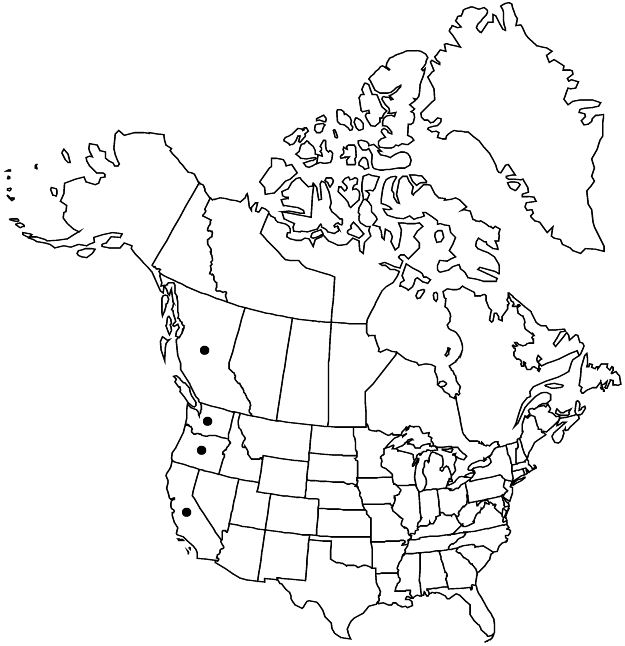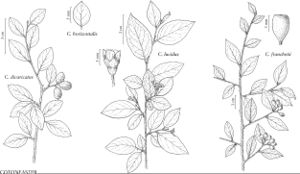Difference between revisions of "Cotoneaster franchetii"
Rev. Hort. 74: 380, figs. 159–161, 164. 1902.
FNA>Volume Importer |
imported>Volume Importer |
||
| (6 intermediate revisions by 2 users not shown) | |||
| Line 10: | Line 10: | ||
|special_status={{Treatment/ID/Special_status | |special_status={{Treatment/ID/Special_status | ||
|code=F | |code=F | ||
| − | |label= | + | |label=Illustrated |
}}{{Treatment/ID/Special_status | }}{{Treatment/ID/Special_status | ||
|code=I | |code=I | ||
| Line 31: | Line 31: | ||
|elevation=0–700 m | |elevation=0–700 m | ||
|distribution=B.C.;Calif.;Oreg.;Wash.;Asia (China);introduced also in Europe;Pacific Islands (New Zealand);Australia. | |distribution=B.C.;Calif.;Oreg.;Wash.;Asia (China);introduced also in Europe;Pacific Islands (New Zealand);Australia. | ||
| − | |discussion=<p>Reports of Cotoneaster franchetii from Colorado (J. Ells 2006) are here referred to C. lucidus. A few specimens escaped in Washington have red filaments, not pink, but otherwise agree with C. franchetii. Other escapes in Washington suggest the closely related C. wardii W. W. Smith, distinguished by semievergreen habit, longer fertile shoots, more lax and elongate inflorescences, and white anthers. The entire complex needs biosystematic review.</p> | + | |introduced=true |
| + | |discussion=<p>Reports of <i>Cotoneaster franchetii</i> from Colorado (J. Ells 2006) are here referred to <i>C. lucidus</i>. A few specimens escaped in Washington have red filaments, not pink, but otherwise agree with <i>C. franchetii</i>. Other escapes in Washington suggest the closely related C. wardii W. W. Smith, distinguished by semievergreen habit, longer fertile shoots, more lax and elongate inflorescences, and white anthers. The entire complex needs biosystematic review.</p> | ||
|tables= | |tables= | ||
|references= | |references= | ||
| Line 40: | Line 41: | ||
-->{{#Taxon: | -->{{#Taxon: | ||
name=Cotoneaster franchetii | name=Cotoneaster franchetii | ||
| − | |||
|authority=Bois | |authority=Bois | ||
|rank=species | |rank=species | ||
| Line 55: | Line 55: | ||
|publication title=Rev. Hort. | |publication title=Rev. Hort. | ||
|publication year=1902 | |publication year=1902 | ||
| − | |special status= | + | |special status=Illustrated;Introduced |
| − | |source xml=https:// | + | |source xml=https://bitbucket.org/aafc-mbb/fna-data-curation/src/2e0870ddd59836b60bcf96646a41e87ea5a5943a/coarse_grained_fna_xml/V9/V9_784.xml |
|subfamily=Rosaceae subfam. Amygdaloideae | |subfamily=Rosaceae subfam. Amygdaloideae | ||
|tribe=Rosaceae tribe Gillenieae | |tribe=Rosaceae tribe Gillenieae | ||
Latest revision as of 22:59, 5 November 2020
Shrubs, 2–3 m. Stems erect, arching, lax, slender; branches distichous, maroon, initially densely pilose-strigose. Leaves persistent, often 30–40 mm apart; petiole 2–4 mm, tomentose-pilose; blade ovate or elliptic, 22–58 × 12–29 mm, coriaceous, base cuneate or obtuse, margins flat, veins 4 or 5, sunken, apex acute or acuminate, mucronate, abaxial surfaces silvery-tomentose, adaxial grayish green, slightly shiny, not glaucous, flat, rarely slightly bulging between lateral veins, drying slightly rugose, pilose. Inflorescences on fertile shoots 30–60 mm with 4 leaves, 5–15(–25)-flowered, compact. Pedicels 1–4 mm, densely long-silky hairy. Flowers (5–)7–8(–10) mm, opening small; hypanthium cupulate, densely long-silky hairy; sepals: margins villous, borders purple, glabrous, apex cuspidate or acuminate, surfaces silky hairy; petals erect-incurved, pink or red, base dark pink to dark red, margins off-white; stamens 16–21, filaments pink, distally white, anthers pink or purplish pink; styles 2 or 3(or 4). Pomes orange-red, obovoid base rounded or obconic base cuneate, straight-sided, 8–12 × 6–9 mm, apex flat, shiny, not glaucous, sparsely pilose; sepals flat, often asymmetric with 2 sepals longer than others, tomentose; navel slightly open; style remnants 3/4 from base. Pyrenes 2 or 3(or 4). 2n = 68 (Germany).
Phenology: Flowering May–Jul; fruiting Oct–Apr.
Habitat: Edges, thickets, disturbed forests, flood plains, urban waste ground, mossy ledges, wet prairie remnants
Elevation: 0–700 m
Distribution

Introduced; B.C., Calif., Oreg., Wash., Asia (China), introduced also in Europe, Pacific Islands (New Zealand), Australia.
Discussion
Reports of Cotoneaster franchetii from Colorado (J. Ells 2006) are here referred to C. lucidus. A few specimens escaped in Washington have red filaments, not pink, but otherwise agree with C. franchetii. Other escapes in Washington suggest the closely related C. wardii W. W. Smith, distinguished by semievergreen habit, longer fertile shoots, more lax and elongate inflorescences, and white anthers. The entire complex needs biosystematic review.
Selected References
None.
